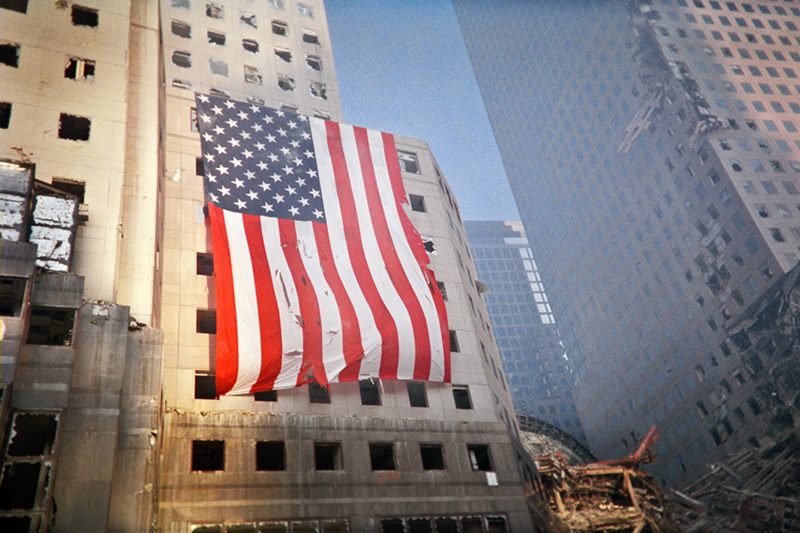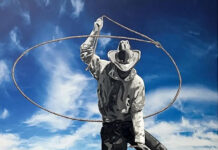Smoke billows from the twisted molten carnage in an opaque deluge, ashy tendrils leaking toxic rubble into the first responder’s lungs. Jarring sirens pierce the terse silence enshrouding New York City. Firefighters weave through the crumpled stairwells, braving each onslaught of fiery waves to reach the stranded civilians. Throngs of onlookers wait outside anxiously and yearn for their loved ones to be next for salvation. A single question plagues each person huddled around their television set: what will we do next?
9/11/2001 staggered the nation, and Jesuit Art Museum’s newest exhibition hopes to capture that day. Ground Zero 360 first debuted in 2011 at the prestigious Field Museum in Chicago, paying a striking tribute to September 11th’s victims on the tenth anniversary. Since then, this multimedia exhibition has inspired countless audiences around the world, viewed by almost 1.3 million people. Numerous foundations and notable individuals have subsequently recognized the outstanding works of art, including Vice President Joe Biden himself.
Photographer Nicola McClean experienced the day’s chaos first-hand, capturing medical staff, firefighters, and the countless family members in her breathtaking photos. After deciding to display her work in tribute to the first responders, McClean received surprise notice from famous Irish artist Jim Fitzpatrick. Painting a 12 piece collection entitled “Lament of the Fallen,” Fitzpatrick’s masterpieces provide a visual contrast to McClean’s gripping photography, depicting emotional moments layered behind vertical bands of paint. Standing out as many viewers’ favorite painting is a portrait of Moira Smith, the only female officer killed during the aftermath. The exhibition extends beyond the anticipated, unique centerpieces like a tangible fragment of granite from the World Trade Center, personal items from first responders, and many others transporting the viewer directly into that somber and tenebrous experience.
Jesuit Museum Director Elizabeth Hunt Blanc faced the difficult task of staging the poignant pieces around the busy and active community of students at Jesuit. By threading the gallery through the school’s Traditional Library, Information Commons, and Hall of Honors, she balanced both elements and “found [it] the best way to display the exhibit and not interfere with the school day.” Ms. Hunt Blanc joined the anxious throngs of television viewers during the towers’ collapse, tormented with worry for her family in New York. For Ms. Blanc, McClean’s American flag and image of firemen revive these emotions. The display not only showcases breathtaking works of art, but also mirrors the museum’s mission “to enhance the educational experience of students and the broader community.”
Global exhibitions like Ground Zero 360 help place Jesuit Dallas on the world map of museums, and Mr. Tom Garrison, Principal of Jesuit, hopes students take advantage of this incredible opportunity. From an administrative perspective, Mr. Garrison sees Jesuit’s hybrid of art and education as a strength, affirming “art should not be something you should have to go to, art should just be all around us. And here it is.” Nearly fourteen years ago, shaken by the news of the first tower, Mr. Garrison continued teaching a class of freshman, maintaining calm and regularity during a time of hysteria. Gut wrenching and raw glimpses like these recreate “a very confusing time and a frightening one, seeing this exhibit brought back a lot of those feelings I had forgotten about.” Garrison praised the display’s candor and realism, presenting the scarring losses and suffering without restraint. This striking viewpoint helps prepare students for the reality outside Jesuit, “the better we understand the world we’re going out into, the better prepared we are to work with it.”
Finally, no one truly will truly understand the vision and emotions behind this exhibition quite like Art Preparator Martin Irwin. Mr. Irwin travels with the pieces every step of the journey, tasked with “transporting the exhibit to museums, set up, take down, creation, and logistics.” After traveling around the world, Irwin found the FBI Academy in Quantico and the Yitzhak Rabin in Israel to be the most interesting venues. However, Jesuit’s fusion between school and museum stood out as unique among the others “because it takes you around half the school through the learning environment,” according to Irwin. Each layout of the exhibition differs from its predecessors, and the Jesuit format physically demonstrates the connectivity between 9/11 and everyday life. Students gain special insight with each visit, this tragic day’s events only a foggy memory of early childhood. Irwin hopes the experience will “help people understand the hurt and loss” the nation underwent and instill further gravity to the annual 9/11 memorials.
As the project’s founder Nicola McClean declared, “it is our responsibility to remember. It is our responsibility to never forget.” Although this horrific accident occurred fourteen years in the past, the duty rests with the current generation to safeguard these heroic acts of patriotism and selfless sacrifice. We can never undo the tragedy which befell so many, however, memorials like Ground Zero 360 ensure the fallen martyrs will endure throughout the duration of recorded history.
The gallery officially opens September 10th at 5 pm.






